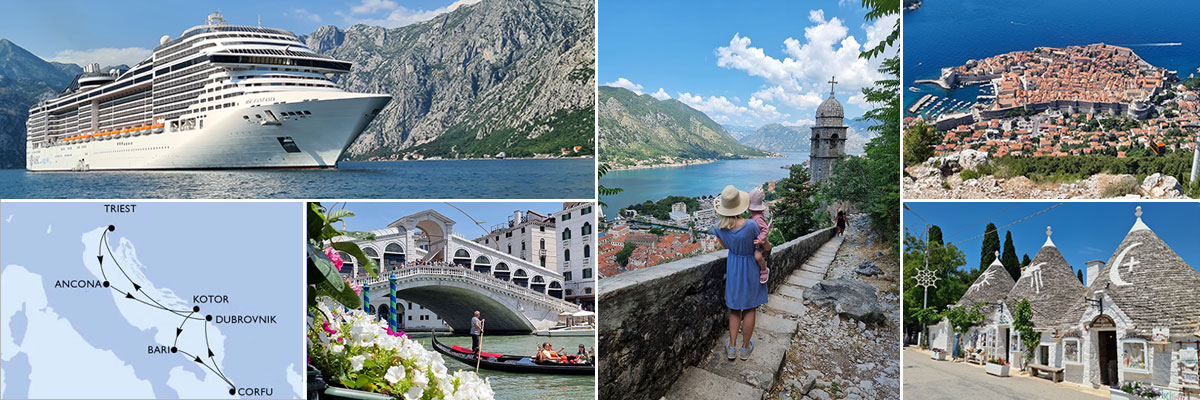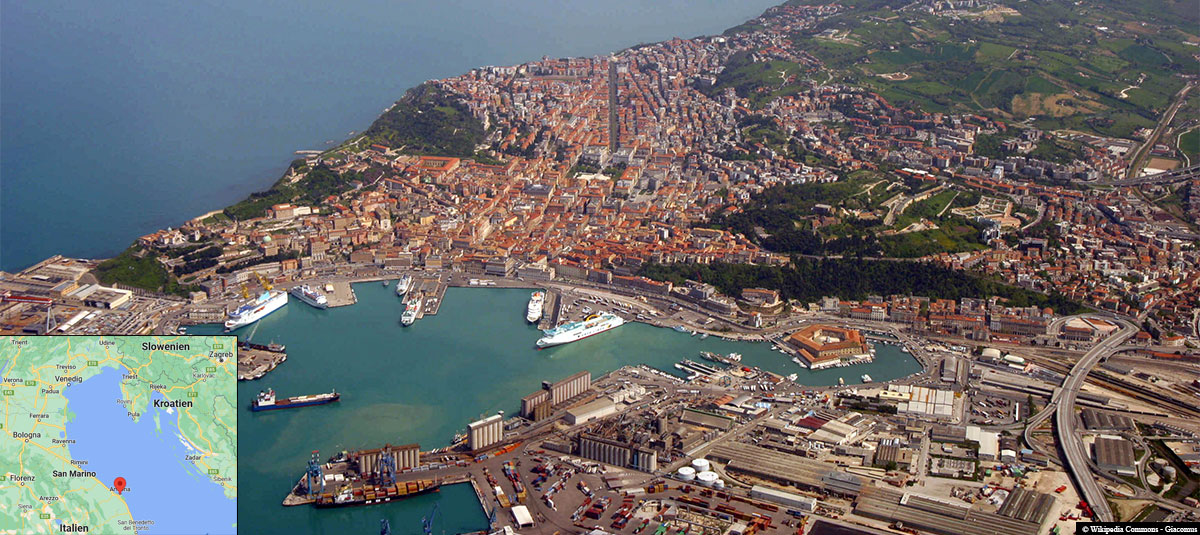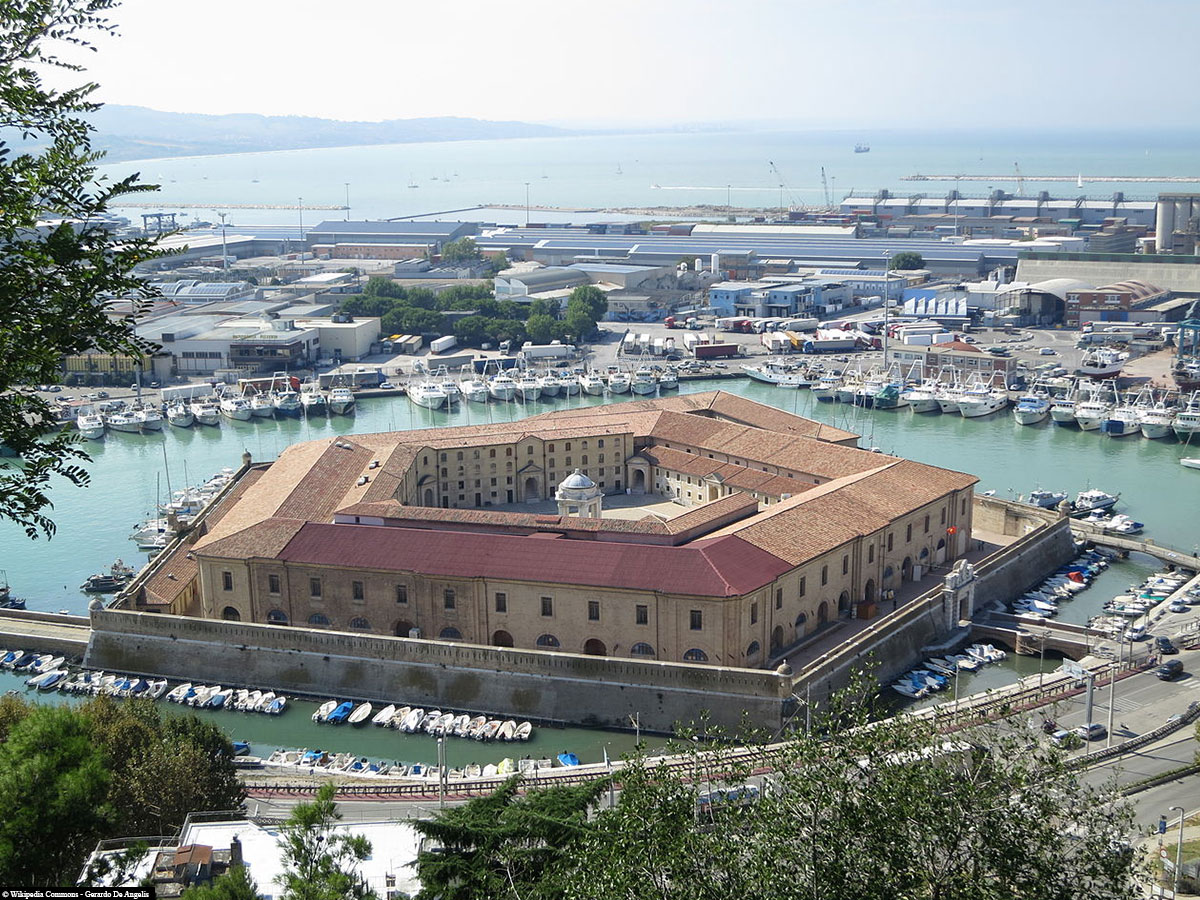The city of Ancona in Italy was the first stop on our cruise through the Adriatic Sea with MSC Cruises. Since we knew Ancona only by name so far, we were very excited about this destination. We had about 5 hours to explore the most famous sights and photo spots of the old town on our own.

Table of contents
Things to know about the city of Ancona
The port city of Ancona has about 100,000 inhabitants and is located on the Italian Adriatic coast. Its unique position made Ancona an important commercial center on the Adriatic Sea since ancient times. The headland forms an elbow around the historic old town, whose foundation by Greek settlers dates back to 390 BC. The bent arm as the emblem of the city lasted on the coins from Ancona until the Roman period. Today the city is one of the most important commercial ports in Italy. Numerous ferries connect Ancona with Croatia, Greece and Turkey.
Unfortunately, not much of the many historical sites from the Roman period, as well as from Ancona’s heyday between the 10th and 14th centuries, remain today. Allied bombing during World War II destroyed 75% of the city, and further irreparable damage was caused by an earthquake in 1972. Among the most important monuments are the Duomo, Trajan’s Arch, Porta Pia, the National Archaeological Museum, the Lazzaretto and the church Chiesa di San Francesco alle Scale.
The pier of the MSC Fantasia in Ancona
The berth of the MSC Fantasia in Ancona was not really ideal. Most cruise ships dock directly at the “Molo XXIX Settembre”, centrally located in the old town. MSC docked a bit outside at the container port (Banchina 25), so you couldn’t get off the ship and into town on your own from there. We had to take an extra transfer bus, but at least it was free and got us from the ship to Piazza Cavour in the city center (and back again) within 10 minutes.
Ancona – Sights & Photo Spots
With perfect weather and bright blue skies, we had from 9am to 3pm to explore the city on our own. Since most of the sights are relatively centrally located in the old town, this was easily doable in the allotted time.
The shopping street Corso Giuseppe Garibaldi
Our transfer bus took us from the ship directly to Piazza Cavour, one of the four main squares in the historic center of Ancona. The square was designed in 1862 after the unification of Italy and inaugurated in 1868. From there, the main shopping street Corso Giuseppe Garibaldi leads through Piazza Roma to the port. In Piazza Roma you can find the Calamo Fountain, also known as the “Fountain of the 13 Pipes”. This very old monument from the Greek period was demolished in 1503 and its stones were used for the construction of the arcades of the Old Palace. According to a drawing by the architect Pellegrino Tibaldi (1560), the fountain was realized in its current form by artists and integrated into the city wall of that time. Unfortunately, the fountain was completely scaffolded during our visit due to renovation work.
Triumphal arches and Roman gates
The city of Ancona has several triumphal arches and Roman gates, all located around the port area.
Porta Pia: The arch of Porta Pia is a monumental gate built by Pope Fromm the Sixth in the 18th century.
Arco Clementino: The Arco Clementino is a monument from the 18th century in honor of Pope Clement the XII. The latter made Ancona a free port in the 17th century, offering new incentives to boost the economy. In 1738, as part of the modernization of the port facilities, he gave an architect the task of building an arched monument “to make the entrance to the city and Papal States catch the eye of arriving foreign merchants”.
Trajan’s Arch: Trajan’s Arch, also located on the pier, was already built between 100 and 115 AD in honor of Emperor Trajan.
The Mole Vanvitelliana
Just inside the port stands the Lazzaretto, a huge pentagonal fortress that once served as a quarantine station for plague sufferers and had a capacity of 2,000 people. It is also known as Mole Vanvitelliana, after the architect Luigi Vanvitelli, who designed it in the 18th century. Due to its special characteristics, it became a military fortress in 1860, a sugar refinery in 1884 and a place for tobacco production in 1947. Today it hosts cultural events, temporary exhibitions, shows and festivals.
The Piazza del Plebiscito
Piazza del Plebiscito, also called Piazza del Papa, is the oldest of the four main squares of Ancona. It was opened in the 15th century and was the central square of the city until the expansion of the city after the Italian unification. Its shape is unique: it is rectangular and very elongated. Another distinctive feature is the fact that it includes several levels, which are connected by two ramps and stairs. It is overlooked by some of the most important buildings of the city: the Palazzo del Governo with its tower, the church of San Domenico and the statue of Clement XII.
Mount Guasco & Ancona Cathedral
Monte Guasco, with a height of 64 meters, is the local mountain of the city of Ancona and the oldest settlement center of the city. On its top is the Cathedral of Ancona, built between the 11th and 13th centuries. We found the cathedral relatively unspectacular, but you have a wonderful view of the city and the harbor from here. On our way back to the city center we passed by Palazzo degli Anziani, the old municipal seat of the city since the 13th century. It is located in Piazza Stracca, opposite the church Chiesa del Santissimo Nome di Gesù.
Other sights in the old town
Throughout the city there are other photo spots worth seeing, such as the churches of Saint Francesco of Scale and Chiesa di Santa Maria della Piazza, the Porta San Pietro, the Teatro delle Muse in Piazza della Repubblica or the Loggia dei Mercanti, a 15th century building.
Basically, we were happy to be able to visit Ancona on our trip. But unfortunately we did not find the city particularly beautiful or impressive, so that the 5 hours on site were then also sufficient.
A map with all the sights in Ancona
On the following map at Google MyMaps we have marked for you the most important sights and photo spots in Ancona.
All travelogues of our cruise through the Adriatic Sea
We deliberately chose the 8-day cruise with MSC Cruises from Trieste, as it included some places that had been on our bucket list for a long time. In total, our trip took us through four countries: Italy, Montenegro, Greece and Croatia. We were able to experience six eventful and varied days on land: We started in Trieste, then continued to the port city of Ancona, through the breathtaking Bay of Kotor to Bari. The journey continued to the green island of Corfu and to medieval Dubrovnik with its impressive city walls, from where we returned to Trieste. Since our plane left from Venice, we were even able to make a small detour to the gondola city, which was another highlight of the trip. Cruise Day 1 » MSC Cruises – Cruise with MSC Fantasia in the Adriatic Sea
Cruise Day 1 » MSC Cruises – Cruise with MSC Fantasia in the Adriatic SeaCruise Day 1 » Trieste – Sights & the best Photo Spots in one day (Italy)
Cruise Day 2 » Ancona – The most famous sights in the old town (Italy)
Cruise Day 3 » Kotor – Bay, old town and fortification (Montenegro)
Cruise Day 4 » Bari – Top sights & photo spots in the old town (Italy)
Cruise Day 4 » Alberobello – A day trip from Bari to the Trulli houses (Italy)
Cruise Day 5 » Corfu – Discover the island in one day (Greece)
Cruise Day 6 » Dubrovnik – Top sights & photo spots in one day (Croatia)
Cruise Day 7 » Day at Sea
Cruise Day 8 » Venice - The most famous sights in just one day (Italy)



